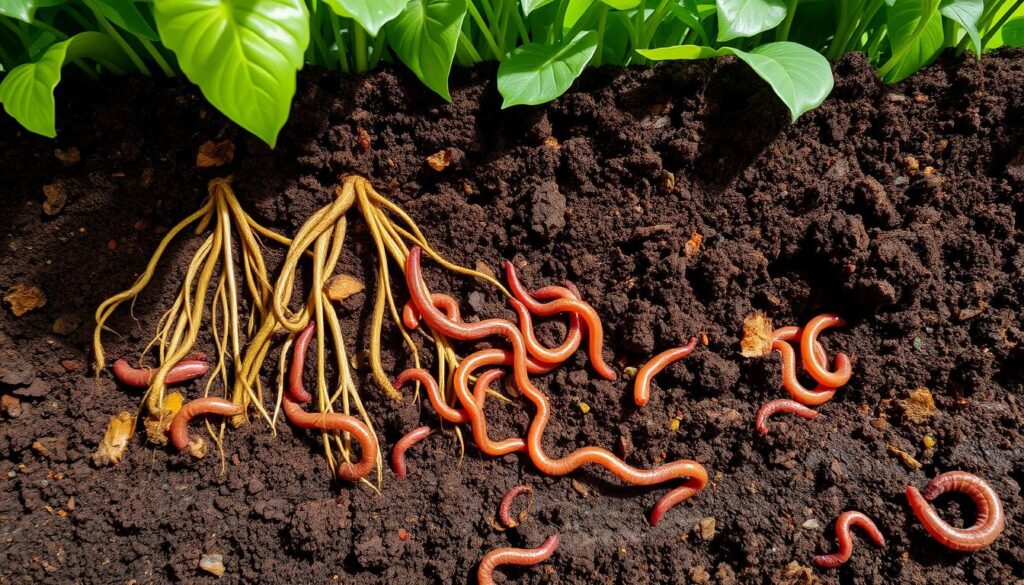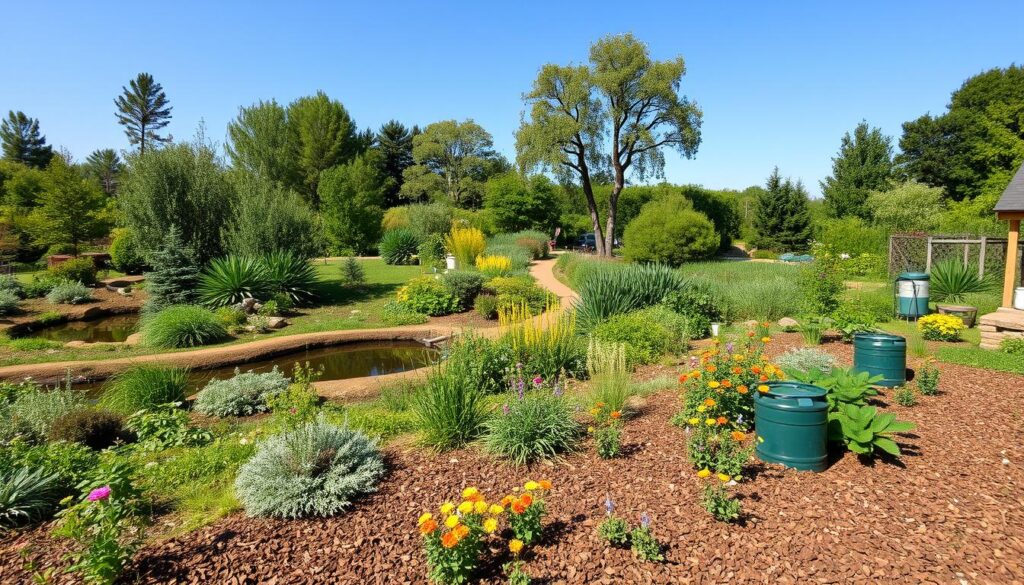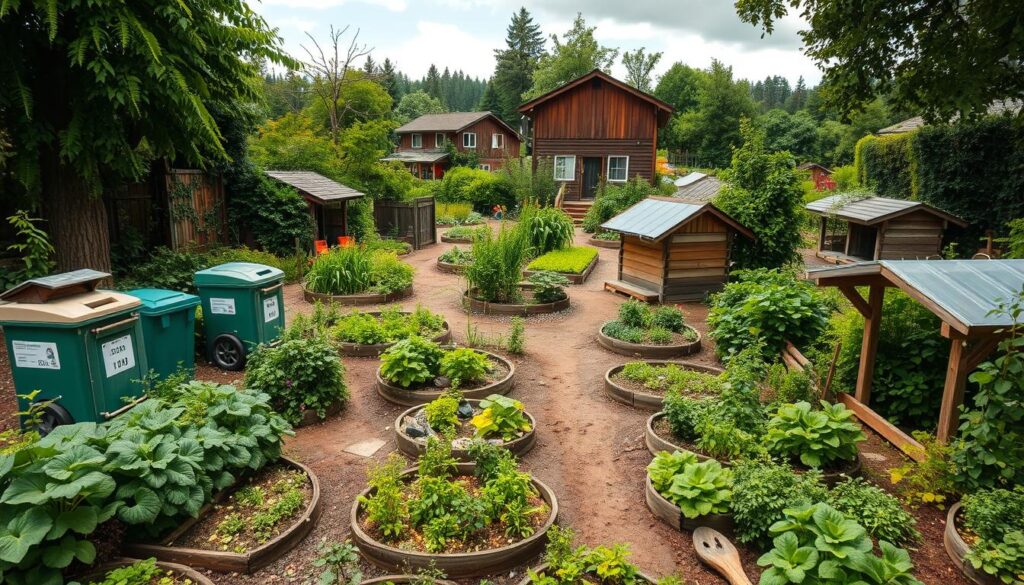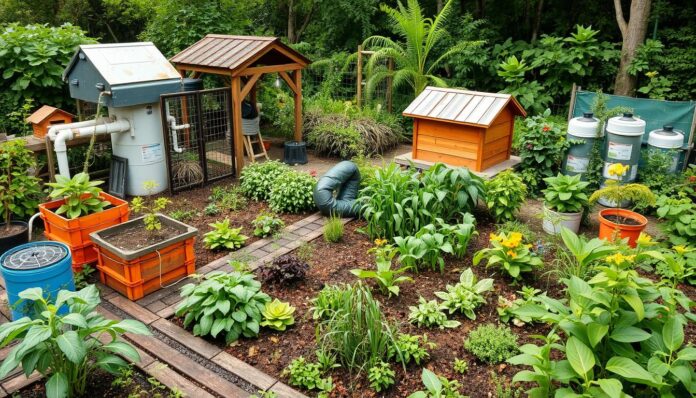Professionals and students from many fields are working on sustainable projects. They ask, what’s the role of permaculture in making systems sustainable? Permaculture combines ecology, systems theory, sociology, and economics. It aims to make human culture sustainable and in harmony with nature.
The goal is to have a system that gives plenty of food, fiber, and energy. This should meet local needs while following ecological rules.
Understanding how humans relate to the environment is key in permaculture. Recognizing the role of resource cycles helps us build sustainable systems. These systems manage both renewable and non-renewable resources.
This approach to sustainable agriculture and design can secure a future for all. It’s about creating a better world for generations to come.
Key Takeaways
- Permaculture design principles aim to create sustainable and regenerative systems.
- Managing resource cycles is crucial in permaculture design to ensure long-term sustainability.
- Permaculture systems integrate ecology, systems theory, sociology, and economics to create a balanced system.
- Renewable resources, such as sunlight and water, are essential in permaculture design.
- Permaculture resource cycles involve managing renewable and non-renewable resources to create a regenerative system.
- Ecological design principles are essential in creating a sustainable agriculture system.
- Permaculture design can help create a better future for generations to come by adhering to sustainable agriculture and ecological design principles.
Introduction to Permaculture Resource Cycles
Permaculture is a way to live sustainably. It uses regenerative farming methods that work with nature. This approach reduces waste and uses renewable resources.
By following circular economy practices, permaculture designs are efficient. They use resources well and don’t need much from outside. This also cuts down on waste.
Organic waste management is key in permaculture. It recycles waste to keep soil and ecosystems healthy. This method also makes a closed-loop system. Resources keep getting used over and over again.
Definition of Permaculture
Permaculture is a design system. It aims to create sustainable and regenerative systems. These systems are like natural ecosystems, diverse, stable, and resilient.
Importance of Resource Cycles in Permaculture
Resource cycles are vital in permaculture. They help use resources efficiently, reduce waste, and keep ecosystems healthy. By designing these cycles, permaculture practitioners can build systems that support biodiversity and ecosystem services.
Key Principles of Permaculture
Permaculture has important principles. These include caring for the Earth, people, and setting limits on population and consumption. These principles help design systems that are good for the environment, society, and economy.
| Principle | Description |
|---|---|
| Care for the Earth | Provision for all life systems, emphasizing biodiversity and ecosystem health |
| Care for People | Access to resources for human survival, reflecting an ethical responsibility toward community welfare |
| Set Limits to Population and Consumption | Sustainable resource management to prevent over-exploitation |
The Concept of Resource Cycles
Resource cycles are the flow of energy and materials in a system. They are key to keeping ecosystems healthy. Soil health and biodiversity are crucial for these cycles. By focusing on these areas, we can use resources better, cut down on waste, and boost ecosystem productivity.
In nature, we see cycles like the water cycle and the nutrient cycle. Rainwater is collected, stored, and reused. Nutrients change forms through decomposition and other processes. Human actions can greatly affect these cycles. It’s vital to use sustainable practices to lessen our environmental impact.
What Are Resource Cycles?
Resource cycles are the ongoing flow of energy and materials in a system. Each part works with others to keep the ecosystem healthy and productive. Human activities like farming, building cities, and changing the climate can influence these cycles.
Examples of Resource Cycles in Nature
- The water cycle, where rainwater is collected, stored, and reused
- The nutrient cycle, where nutrients are converted from one form to another through decomposition and other processes
- The energy cycle, where energy is captured, stored, and utilized by living organisms

Human Influence on Resource Cycles
Human actions, like farming, building cities, and climate change, can affect resource cycles. But, by using sustainable methods, we can lessen our impact. This helps maintain ecosystem health.
| Resource Cycle | Example | Human Influence |
|---|---|---|
| Water Cycle | Rainwater collection and storage | Urbanization and climate change |
| Nutrient Cycle | Decomposition and nutrient conversion | Agriculture and pollution |
| Energy Cycle | Energy capture and storage by living organisms | Climate change and energy consumption |
Soil Health and Nutrient Cycling
Soil health is key in permaculture design. It affects the ecosystem’s fertility and productivity. Nutrient cycling is crucial for soil health. Soil microorganisms play a big role in this process, breaking down organic matter and making nutrients for plants.
Composting is important for soil health. It gives organic matter that helps beneficial microorganisms grow. Sustainable agriculture, like no-till farming and cover crops, helps too. These practices reduce soil erosion and boost nutrient cycling.
- Implementing crop rotation to increase soil biodiversity
- Using mulch to reduce soil temperature fluctuations
- Integrating perennial crops to enhance soil structure
By using these methods, farmers can support permaculture cycles. This makes agriculture more sustainable and productive.
Water Management in Permaculture
Effective water management is key in permaculture. It involves capturing, storing, and reusing water. This keeps ecosystems healthy and productive. For example, adding 5% more organic material to soil can make it hold four times more water, cutting down on irrigation needs.
Some important strategies for managing water in permaculture include:
- Water capture techniques, like rainwater harvesting and greywater recycling, provide water for irrigation and other uses.
- Stormwater management systems, including vegetated swales and bioswales, filter water and manage runoff.
- Using terracing and on-contour swales slows down runoff and helps water infiltrate, reducing erosion and increasing water retention.
Also, using drought-tolerant plants and organic mulching can lower water evaporation. This means less need for irrigation. By adopting these methods, people can make their water management systems more resilient and sustainable. This reduces their use of municipal water and lessens their environmental impact.

By using ecological design and regenerative farming in water management, people can make permaculture more holistic and sustainable. This approach not only helps the environment but also provides a reliable water source for irrigation and other needs. It’s a crucial part of any permaculture system.
| Water Management Strategy | Benefits |
|---|---|
| Rainwater Harvesting | Provides a steady supply of water for irrigation and other non-potable purposes |
| Greywater Recycling | Reduces the amount of wastewater generated and provides a source of water for irrigation |
| Stormwater Management | Filters water and manages runoff, reducing erosion and increasing water retention |
Energy Flow and Resource Cycles
Energy flow is key in permaculture design. It shows how energy moves through a system. This idea is linked to circular economy practices, which aim to cut waste and use resources wisely. In permaculture, it’s vital for keeping ecosystems healthy and productive.
Using organic waste management like composting is important. It helps reduce waste and boosts nutrient cycling. This method cuts down landfill waste and gives plants valuable nutrients. By using circular economy practices and organic waste management, we can lessen our environmental footprint and support sustainable farming.
Examples of energy flow in permaculture include solar and wind power for electricity. Composting is also used to cut waste and boost nutrient cycling. These methods not only lessen agriculture’s environmental impact but also promote energy efficiency and sustainability.
Waste Management and Recycling
Effective waste management is key in permaculture design. It keeps ecosystems healthy and productive. By using closed-loop systems and reusing waste, permaculture helps the environment. It also boosts soil health and supports biodiversity.
Composting is a big part of waste management in permaculture. It turns organic waste into nutrient-rich soil. This not only cuts down waste but also improves soil health and biodiversity.
Some benefits of composting include:
- Reduced greenhouse gas emissions
- Conserved water resources
- Increased soil fertility and structure
- Supported biodiversity conservation strategies
Permaculture also uses other methods to create closed-loop systems. For example, organic waste recycling and using straw for composting. Terraced beds help reduce erosion and boost biodiversity.
By using these strategies, permaculture helps the environment. It promotes soil health and biodiversity. It also makes ecosystems more sustainable and resilient.
| Technique | Benefits |
|---|---|
| Composting | Reduces waste, regenerates soil health, increases fertility |
| Terracing | Reduces soil erosion, increases biodiversity, conserves water |
| Organic waste recycling | Conserves resources, reduces greenhouse gas emissions, supports biodiversity conservation strategies |
Plant Selection and Biodiversity
Choosing the right plants is key in permaculture design. It’s about picking plants that fit the climate and soil. This choice is vital for keeping ecosystems healthy and productive.
By using a variety of plants, permaculture gardens boost biodiversity. They also use water wisely and keep the soil healthy. These are important for sustainable agriculture.
A good permaculture garden can have more than 50 plant species. This variety can make yields 20-30% higher than single-crop farms. Some perks of choosing plants wisely and increasing biodiversity include:
- Higher yields and productivity
- Better soil health and fertility
- More ecosystem services, like pollination and pest control
- Less water use and better water efficiency
By picking plants right for the local climate and soil, permaculture experts create ecosystems that work well with nature. This method cuts down on the need for outside help, like fertilizers and pesticides. It supports permaculture resource cycles. This way, people can help make farming more sustainable and eco-friendly.

Animal Integration in Permaculture Systems
Animal integration is key in permaculture design. It boosts the health and productivity of the ecosystem. Ecological design principles are vital in making sure the ecosystem is balanced and thriving.
Methods like rotational grazing improve soil health and boost biodiversity. This method moves animals to different spots on the farm. It lets the soil recover and get replenished. Integrated crop-livestock systems also help by increasing soil’s carbon and nitrogen, making it healthier.
Animals like sheep, cows, goats, and rabbits can be part of permaculture systems. Each animal offers something special, like milk, meat, or manure. For example, goats eat shrubs and trees, while cows help keep meadows diverse and sequester carbon in the soil.
Adding animals to permaculture systems makes farming more holistic and sustainable. It’s good for the environment and gives farmers a steady food and income source. As more people want sustainable farming, using animals in permaculture will become even more crucial.
Economic Sustainability in Permaculture
Economic sustainability is key in permaculture. It helps keep ecosystems healthy and productive for a long time. By using circular economy practices, permaculture systems cut down on waste and make the most of resources. This method designs systems that work like nature, where waste is reduced and resources keep cycling back.
Organic waste management is a big part of achieving economic sustainability in permaculture. It turns organic waste into useful things like compost or fertilizer. This helps plants grow and keeps the soil healthy. By doing this, permaculture systems use less outside help and harm the environment less.

- Reduced costs through efficient use of resources
- Increased self-sufficiency and food security
- Improved soil health and biodiversity
- Enhanced ecosystem services, such as pollination and pest control
By following economic sustainability, permaculture systems help make food systems stronger and more regenerative. They also support environmental care and social well-being.
| Benefits | Description |
|---|---|
| Reduced costs | Efficient use of resources minimizes waste and reduces expenses |
| Increased self-sufficiency | Permaculture systems can produce a diverse range of crops, reducing reliance on external inputs |
| Improved soil health | Organic waste management and efficient use of resources promote soil fertility and biodiversity |
Climate Resilience Through Resource Cycles
Climate resilience is key in permaculture design. It means adapting to climate change and creating cycles that boost resilience. This is done through soil health regeneration, which helps soil hold more carbon and supports plants.
Effective water management, like rainwater harvesting and swales, keeps crops healthy even in dry times.
Diverse ecosystems in permaculture make them more resistant to pests and diseases. This makes the ecosystem more stable. Biodiversity conservation strategies are vital for keeping ecosystems healthy and productive. Some important strategies for climate resilience include:
- Implementing permaculture practices that enhance soil organic matter content
- Using effective water management techniques, such as rainwater harvesting and swales
- Fostering diverse ecosystems to increase resilience to pests and diseases
- Promoting local food production to reduce transportation-related carbon emissions
By using these strategies, permaculture designers can build systems that are resilient to climate change.
| Strategy | Benefits |
|---|---|
| Soil health regeneration | Improves soil’s capacity for carbon sequestration and supports plant growth |
| Effective water management | Maintains healthy crops even during drought conditions |
| Biodiversity conservation | Enhances ecosystem stability and resilience to pests and diseases |
Tools and Techniques for Permaculture Design
Permaculture design uses tools and techniques to make systems sustainable and regenerative. It focuses on permaculture resource cycles to reduce waste and boost efficiency. This is key for sustainable agriculture, lowering farming’s environmental impact and improving ecosystem health.
Designers employ various tools and methods, like software and apps for planning. These tools help create detailed maps and models. They consider climate, soil, and water availability.
Designing Effective Resource Cycle Systems
Creating effective resource cycle systems is vital in permaculture design. It aims for self-sustaining, regenerative systems with little waste and high efficiency. Key principles include zone analysis and sector analysis to fit systems to site needs and conditions.
Software and Apps for Permaculture Planning
Many software and apps aid in permaculture planning. They help design and model systems, considering climate, soil, and water. These tools create detailed maps and models.
Workshops and Educational Resources
Workshops and educational resources are also available for designers. They offer training and support, helping designers develop skills for sustainable systems.
Topics in workshops include permaculture principles, zone analysis, and sector analysis. These topics lay the groundwork for understanding permaculture design. They help designers tailor systems to their site’s needs and conditions.
Challenges in Managing Resource Cycles
Managing resource cycles in permaculture design means using ecological design principles to make systems sustainable and regenerative. But, there are challenges like using too many insecticides. This can make controlling pests harder.
Finding solutions that are affordable, easy to get, and simple to understand is a big challenge. Regenerative farming methods help by using natural resources and cutting down on costs. For instance, using solar energy can save money on energy for drying clothes, heating water, and cooking.
Some common pitfalls and solutions for resource cycle challenges include:
- Overuse of insecticides: Implement regenerative farming methods such as companion planting and crop rotation to reduce pest incidence.
- Lack of soil health: Use mulch and compost to mimic natural systems, adding to soil health and reducing the necessity for chemical fertilizers.
- Inefficient water use: Implement moisture retention strategies to enhance soil structure and create microclimates, reducing water usage by 30-50%.
By tackling these challenges, permaculture practitioners can make resource cycles more efficient and sustainable. This reduces the need for outside help and boosts ecosystem health and productivity.
| Challenge | Solution |
|---|---|
| Overuse of insecticides | Implement regenerative farming methods such as companion planting and crop rotation |
| Lack of soil health | Use mulch and compost to mimic natural systems |
| Inefficient water use | Implement moisture retention strategies to enhance soil structure and create microclimates |
Community Involvement and Resource Sharing
Community involvement is key in permaculture design. It helps create networks for sharing resources. By working together, people can use circular economy practices to cut down waste and support sustainability. This teamwork allows for the exchange of resources, skills, and knowledge, making permaculture systems more efficient.
Community involvement also means tackling organic waste management together. Members can work on strategies to reduce, reuse, and recycle organic waste. This includes composting and vermicomposting, which turns waste into a valuable fertilizer for crops and improves soil health.
Here are some ways community involvement and resource sharing play out in permaculture:
- Cooperative gardening initiatives, where community members work together to maintain and harvest gardens
- Tool-sharing programs, which allow community members to borrow and share equipment and tools
- Workshops and training sessions, where community members can learn new skills and share knowledge and expertise
By encouraging community involvement and resource sharing, permaculture can lead to more sustainable systems. This approach benefits the environment and strengthens community bonds.
The Future of Permaculture Resource Cycles
Looking ahead, we must think about new ways to manage resources in permaculture. Soil health is key, and keeping ecosystems diverse is crucial. These steps help our planet stay healthy and productive.
Some important strategies for the future include:
- Using regenerative agriculture to improve soil health
- Adding biodiversity to permaculture designs
- Using technology to manage resources better and cut down on waste
By using these methods, we can make permaculture systems more sustainable and strong. It’s important to keep improving and adapting our practices for the planet’s changing needs.
The future of permaculture depends on our teamwork to make food systems better. Focusing on soil health and biodiversity will help us build a better world for future generations.
| Strategy | Benefits |
|---|---|
| Regenerative agriculture | Enhanced soil health, increased biodiversity |
| Biodiversity conservation | Promotes ecosystem health, supports pollinators |
| Technology integration | Optimizes resource management, reduces waste |
Conclusion: The Importance of Resource Cycles
The principles of permaculture resource cycles are key to keeping our ecosystems healthy and productive. By following nature’s lead, we can create sustainable farms and homes that waste less and work better.
This article has shown us the key concepts of permaculture. From how nutrients and water move to how energy flows and waste is reused. These ideas help us build strong, adaptable communities for a greener future.
We all need to make greener choices. This can be in our daily lives, through community projects, or by pushing for change in laws. By using permaculture’s wisdom, we can make our world a better place for everyone.
If you want to learn more about permaculture, look for educational materials, join local groups, or take workshops. Together, we can make a world that’s more just and sustainable, one step at a time.

